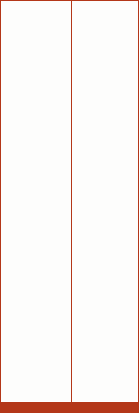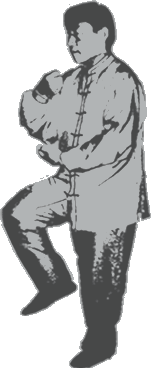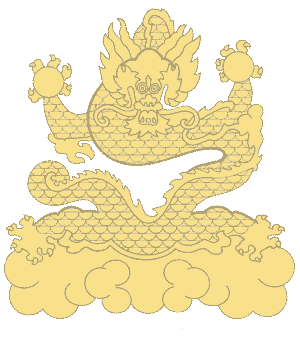By Herb Rich
Photos and text copyright 1999 by Herb Rich
Over sixty Taijiquan enthusiasts gathered at the Sheraton LaGuardia
Hotel in Flushing, NY on Sept 25 and 26 of 1999 to study with Grandmaster
Chen Xiao Wang at the final seminar of his fourth annual tour of the
US. Sponsored by Grandmaster Chen’s senior disciple Ren Guang
Yi of New York, the seminar attracted a wide mix of students, from
instructors to beginners. The topic of this year’s seminar was
Grandmaster Chen’s 19 posture form and it’s applications
for self defense.
Born in 1946 in Chenjiagou, Chen Xiao Wang is considered to be the
19th generation "standard bearer" of Chen family Taijiquan.
He is the direct descendant of the founder of the art, Chen Wang Ting.
He began his training at the age of eight under the tutelage of his
father, Chen Zhaoxu. He later continued his studies with Chen Zhao
Pi and Chen Zhao Kui, eventually becoming known as one of the "four
warrior attendants" of Chenjiagou (a title denoting his status
as one of the top practitioners of his generation).
Following an impressive string of triumphs in national competitions
and appointments to prestigious coaching positions, he immigrated
to Australia in the early part of the 1990s. He currently spends the
better part of each year traveling across the globe, spreading the
teachings of his ancestors. His seminars and classes are eagerly anticipated
by enthusiasts the world over.
Over many years of teaching, Grandmaster Chen has developed an effective
methodology for teaching large groups of people. This system, used
in the New York seminar, consists of solo demonstration (repeated
thruout each session), the breaking down of the movements of each
posture into "counts", the correction of student models
on stage (in this case, Gregory Pinney, an instructor and senior student
of Ren Guang Yi), paired student work (in which students correct each
other, referring to the model on stage, and following Grandmaster
Chen’s direction), individual correction by Grandmaster Chen
when needed, and question and answer sessions.
Created four years ago in response to demand from students for a short
routine suitable for beginners, the form is composed of 19 movements,
divided into four sections. The simplicity of the form’s choreography
facilitates easy assimilation by the novice, yet offers the experienced
practitioner room to express and develop the basic principles, energies
and techniques of the style.
It features the signature postures of traditional Chenstyle Taijiquan
(with the notable exception of Dan Pien (Single Whip) and Bai Huo
Liang Qi (White Stork Cools Wings). There are a few notable variations
on these postures found through the form. The posture Yu Nu Chuan
Suo (Jade Maiden Works Shuttles) lacks the heel kick of the Lao Jia
version. The Deng Yi Gen (heel kick) postures combine the initial
lu ("roll back") and qin na ("catch and hold")
movements of the posture Ca Jio (slap foot) found in Lao Jia I Lu
with the kicking technique of Deng Yi Gen from that form.
The form is a combination of postures from the three major styles
of ChenJiagou Taijiquan. It contains several postures from the Xin
Jia style, including Shang Bu Xie Xing, Dao Juan Hong, and Yeh Ma
Fen Zhong. These postures are fairly simple, and avoid the complex
coilings that are the signature of the style. Also included are postures
from the Xiao Jia style, including Shuang Tui Shou, Shan Tong Bei,
and Liu Feng Si Bi. The balance of the form- about two thirds of the
routine- are from the I Lu Lao Jia routine.
The movements of the 19 posture form
Section 1:
1. Yu Bei Shi "Beginning Form"
2. Jin Gang Chu Miao "Warrior Attendant Emerges from Temple"
3. Lan Zha Yi "Lazily Tying Coat"
4. Shang Bu Xie Xing "Forward Step with Diagonal Posture"
5. Shang San Bu "Stepping Forward Three Times"
6. Zou Yang Shou Hong Quan "Left Hidden Thrust Punch"
7. Shuang Tui Shou "Double Pushing Hands"
Section 2:
8. Dao Juan Hong "Turning Arms Backward"
9. Shan Tong Bei "Turning the Back"
10. You Yan Shou Hong Quan " Right Hidden Thrust Punch"
11. Liu Feng Si Bi "Six Sealing and Four Closing"
Section 3:
12. Yun Shou "Cloud Hands"
13. Gao Tan Ma "High Pat on Horse"
14. You Deng Yi Gen "Right Heel Kick"
15. Zou Deng Yi Gen "Left Heel Kick"
Section 4:
16. Ye Ma Fen Zhong "Parting Horse’s Mane"
17.Yu Nu Chuan Suo "Jade Maiden Works Shuttles"
18. Jin Gang Dao Dui "Warrior Attendant Pounds Pestle"
19. Shou Shi "Closing Form"
The rhythm and flavor of the form reflects the classic attributes
of Chen style, showing especially the influence of Lao Jia I Lu: the
mixture of soft and hard, with softer movements predominating: and
the mixture of fast and slow, with slower movements predominating.
As in I Lu, the body leads the hands in the majority of the movements.
As in other forms of traditional Chenstyle, there are three methods
of practice - high, middle, and low, referring to the height of the
practitioner’s stance. The form can be practiced "softly",
or with pronounced martial intent. At one point, when discussing application,
Grandmaster Chen demonstrated the first section for the group in this
manner. It was notably different from the softer style he had been
demonstrating previously. The rhythm and pace of the movements (much
quicker, as though actually fighting), and the spirit (shen) exhibited
were enthralling to watch. As always, Grandmaster Chen‘s fajing
was exemplary. It was a rare treat to see a taiji form performed with
"a sense of the enemy" at this level of skill.
Applications shown by Grandmaster Chen were, for the most part, simple
and effective, and they seemed to be of two categories: redirecting
incoming force, controlling the attacking limb and countering, or
evading the incoming force, and countering. Grandmaster Chen demonstrated
the applications solo with fajing, and then slowly with a partner.
The class would then practice the applications in pairs, heeding Grandmaster
Chen’s admonitions to avoid the use of injurious force.
The postural applications shown exhibited the basic four jings of
Taijiquan; peng (found thruout the applications), lu (used to redirect
an attack in Shuang Tui Shou, and Liu Feng Si Bi), ji (in Lan Zha
Yi, and Yan Shou Hong Quan) and an (in Qi Shi). This is only a partial
listing.
Also demonstrated were the usage of Kao, (in Xie Xing, and Yeh Ma
Fen Zhong),
zhou, (in Dao Juan Hong), lieh (in Gao Tan Ma) and cai. (in Shan Dong
Bei). Again, this is only a sampling.
Applications utilizing other jings were shown. Some examples were
Teng (rising) in Yu Nu Chuan Suo, Shan (dropping or dodging) in Shan
Tong Bei, and Da (hitting) in Yan Shou Hong Quan and Shang San Bu.
The seminar was, in retrospect, well organized and carried out. It
was a rare opportunity to witness the art played on a high level by
a skilled artist.
It is said that the greatest of artists express a simplicity in their
work. Appearing almost effortless, their art is an expression of long
years of study, understanding and insight. Despite it’s simple
appearance, such skill is never easy to duplicate. So it is with the
19 posture form of Chen Xiao Wang: a choreography of deceptive simplicity.
|



